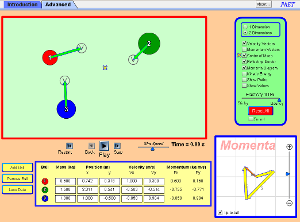Yesterday, you looked at http://www.edheads.org/activities/crash_scene/swf/index.htm
You must experiment with the WHAT IF scenarios using your pool table. You also should be watching the information on the 'collecting evidence' as it directly relates to the activities below.
STEP 1: Collect the data for a collision representing the situation in the edheads crash. Use two similar sized marbles.
Problem:
How can you use the conservation of momentum to prove to a judge that you were not speeding and therefore do not deserve a ticket for the collision?
Materials:
Paper, Logger Pro, video, safercar.gov, protracter, ruler.
Procedure:
You leave the school teacher's parking lot and are traveling north when you are broadsided by a car traveling east. The collision occurs in a school zone with a speed limit of 20 mph. The impact throws you into the band practice field.
Following the collision the police officer determines that both vehicles had a speed of 22 mph (9.8 m/s). The driver of the other car is an adult and claims that you were speeding and consequently should receive a ticket. You are to prove your innocence by using the conservation of momentum.
Research:
What type of a vehicle were you driving? What type of a vehicle was the other driver riding in? Look again at the safety and the mass of these vehicles at the NHSTA site (http://www.safercar.gov ). Use the same vehicle you looked up earlier this week.
Your vehicle_______________ Mass or weight____________
Their vehicle_______________ Mass or weight____________
Decide on the units for your momentum and record here ____________
Draw a diagram of the two cars just prior to impact. You were headed north, the other car was headed East. Choose a scale (e.g., 1 cm = kg m/s) or freehand draw a diagram of the vehicles before AND after the impact your calculation .
There are two possible cases. In Case 1, you were going 20 mph. In Case 2, they were going 20 mph. One things for sure. After the collision, you were stuck together and both of you traveled at 22 mph.
Do one set of calculations for each Case.
STEP 2: MODEL THIS COLLISION USING two balls of similar diameters but different masses. Because the collision described above is inelastic, the balls must stick together and slide after impact.
STEP 2: MODEL THIS COLLISION USING two balls of similar diameters but different masses. Because the collision described above is inelastic, the balls must stick together and slide after impact.
Summing Up (each person does this individually,1/2 to 1 page, and hands it in paper clipped to the diagrams)
1. Qualitatively explain, using your diagrams, how you know that you were not going faster than the adult. Remember that a ticket means higher insurance rates and a large fine.
2. Do you think you were you speeding?
3. How would angles affect your logic?
4. What evidence of impulse or guilt would the police collect in this action?
5. Based on the safety rating of the vehicles involved, what do you think the extent of the injuries would be?
6. What role did impulse play in the safety factors present in your vehicle?
5. Based on the safety rating of the vehicles involved, what do you think the extent of the injuries would be?
6. What role did impulse play in the safety factors present in your vehicle?




